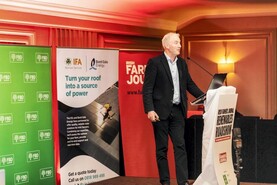“We’re not looking to cull our herd,” says Minister for Agriculture Charlie McConalogue. “What we’re looking to do is provide options.”
The newly re-appointed minister is reacting to the Climate Action Plan released on 21 December, and responding specifically to Meat Industry Ireland’s claim that a cull of 200,000 suckler cows is needed to meet agriculture’s sectoral target of a 25% reduction in emissions by 2030.
It’s clear that a targeted cull is not at the front of his thinking.
“In relation to the beef herd, the Food Vision group will be important in terms of how we step it out. All of the farm organisations and beef processors were opposed to any voluntary reduction to the suckler sector, and we’re all united and at one in relation to that,” he says.
“I will be looking to implement diversification options in a way that incentivises emissions reductions. I want to engage further with the stakeholders in the Food Vision groups in the new year, to bring clarity to any voluntary reduction scheme,” he adds.
“The suckler sector is the anchor of our beef sector nationally, it’s something I’m very passionate about maintaining. Our previous Climate Action Plan was bringing us to 18% [emissions reduction], so we have to increase the ambition,” he says.
“One of the key steps forward is working towards the capacity to embrace technology that will facilitate feed additives at pasture, we see a gain in that. There is also increased ambition around diversification alternatives.
“The biggest step-change there is around anaerobic digestion (AD). The target is that by 2030, we will have 10% of our total requirement for natural gas being generated from farms through AD and biomethane. That offers a new opportunity for farmers in being able to feed those plants. It’s been developed in other countries in a way that we haven’t, so the potential is there.
“There is potential in relation to afforestation, also in relation to solar energy,” he continues.
“We are also targeting an increase in tillage acreage as well. There is potential there to build on what we have achieved already there. All of those are being done in a way that is encouraging and providing voluntary options to farmers.”
Without a suckler cull, what is the future for dairy?
“Dairy expansion has significantly plateaued and we’re seeing that this year in particular,” responds the minister.
Good grass production, for AD or for animal production, will not be dependent on more fertiliser
“The challenge going forward is to continue to be very productive in terms of producing food, but doing it in a way that brings our emissions down. If you look at between 1998 and 2011, we saw emissions from Irish agriculture drop by 15%.
“There was no climate roadmap in place then, it happened by farmers becoming more efficient in what they were doing.”
That period saw a reduction in the suckler herd due to BSE and a static milk pool filled by fewer dairy cows as milk production became more efficient.
“With the build-up to the removal of quotas and the very beneficial economic activity of post-quota expansion, we saw emissions levels rise to 2018,” he concedes.
“We have seen further dairy expansion since 2018, but our emissions level in 2021 is no higher than 2018.
“Efficiency gains offset the increased dairy output. We now have to drive emissions levels down. The focus now is on implementing those actions I’ve outlined that will achieve that.”
Anaerobic digestion
Anaerobic digestion seems to be the magic bullet, with 200 large-scale plants planned for 2030. Won’t they need a lot of feeding and inputs?
“Good grass production, for AD or for animal production, will not be dependent on more fertiliser. We are seeing the benefits of high clover swards and of multispecies swards. My understanding is that works well with AD,” he says.
“We’re going to need a renewable heat obligation that will underpin AD as the ongoing economic driver.
“But there will also be capital support.
“We are putting together an AD strategy across Government to deliver both those supports, and we need to make sure that happens quickly, to provide the confidence for investment,” he pledges.






 This is a subscriber-only article
This is a subscriber-only article










SHARING OPTIONS: